Digital artist | Mostly worldbuilding, spec evo and conlanging | Sometimes paleoart | Italian | Open to commissions
Last active 3 hours ago
Don't wanna be here? Send us removal request.
Text

Two critters I made for the Lemuria event on the PaleoStream server, a marsupial (top) and a gondwanathere (bottom)
42 notes
·
View notes
Note
Hello 👋,
I hope this message finds you well. My name is Aziz, and I’m reaching out with a heartfelt plea to help my family find safety and reunite with our mother. 😞
The ongoing war in Gaza has torn my family apart. My mother and newborn sister are stranded in Egypt, while I, along with the rest of my sex family members, am trapped in the midst of the genocide in Gaza. We have not only been separated but have also lost our home and are enduring unimaginable hardships. 💔
Your support can make a difference. Whether by reading our story, donating, or sharing our campaign with others, you can help us reunite, find safety, and start anew. 🙏🕊
Thank you, from the depths of my heart, for your kindness, compassion, and solidarity during this difficult time. ❤🍉
https://gofund.me/58268669 🔗
.
2 notes
·
View notes
Text
As it’s been happening for the last 15-20 million years the planet has been slowly cooling down, and now, 30 million years after the Anthropocene mass extinction, it has finally reached a point when it can be defined as in a true ice age, and now we have reached the Campleocene epoch.

In the heart of Eurasia, extending all the way back in North America, an environment resembling the Pleistocene mammoth steppe has started to flourish again in the glaciers’ shadow, inhabited by vast herds of herbivores, whose grazing and stomping, along with the high aridity of the biome, didn’t allow for many plant taller than a bush, with only a few isolated trees scattered across the plains. This environment, the borroth steppe, named after one of its most charismatic inhabitants, hosts an incredible biodiversity in both fauna and flora, helped by the mountain ranges, the Altai, the Pyrenees, the Carpathians, … , and the patches of forest that fracture it and result in plentiful reproductive barriers.
The most common grazers across these plains are lagomorphs and even-toed ungulates. Heers (the deer like descendants of Eurasian hares) , and to a lesser extent jackalopes (similar to the former but more browsing and horned), more common in forests. They travel in small gender-specific bands, ten to twenty individuals at most.
The even-toed ungulates that inhabit these steppes are quite varied in niche and size, going from animals reaching a ton in weight to lanky 20 kilos runners. Most of them come from African ancestors, descended from grysboks or dik-diks, although there’s many Eurasian locals too, with saiga descendants, Saiginae, now having become almost llama or camel like and are a common sight from Spain to British Columbia, and feral goats descendants, previously only found on mountains, now having come down to the lowlands thanks to a more favourable climate for them.
The smaller mammals populating the steppe are mostly rodents and lagomorphs, relatively unchanged from the Holocene, with lemmings, voles, mice and hares being quite common, and the only real addition being ratjacks (Rattopus descendants), jumping rats that like goats came down from the mountains thanks to the change in climate.
There’s a wide variety of birds inhabiting these plains. Other than passerines the most common birds are fowl, both gamefowl and waterfowl, along with cranes, who are most common around marshes around the borroth steppe, but were able to exploit the variety of low growing plants and expand into it.
Some of the largest herbivores of these lands are giant hyraxes, part of yet another lineage originating in the mountains, who now sport on their snout a pair of, usually straight, horns that they use to fight amongst themselves. Weirdly enough, even though they live in a grass rich environment, most species in this lineage seem to prefer eudicot plants, with many being functionally browsers of low bushes

The largest animals here, though are the borroths, holophants part of the tribe Borrothini, there’s currently five species of them, two mountain ones, the Himalayas (Cryoborrothus orientalis) and Caucasian borroths (Plioborrothus pygmaeus), and three steppe ones, the Mediterranean (Euborrothus meridionalis), Common (E. vulgaris) and Beringian borroths (E. cryophilus).
They’re extremely generalist herbivores that are willing to eat most plants they encounter, grass, bushes, trees, moss, lichens, etc… , though, similarly to their ancestors they prefer the carbohydrate and lipid rich foods, like tubers and berries. Another similarity to their suilline ancestors is their social structure, as sows and farrows live in close knit family groups, while males live in bachelor groups, though they tend to part ways as they age, especially during breeding season, as they become extremely territorial, especially in resource rich areas, in order to attract female herds.
#spec evo#spec bio#speculative evolution#speculative biology#artwork#digital art#worldbuilding#epigene period#future earth#future evolution
22 notes
·
View notes
Text
We are approaching the maximum of images you can post here so I thought it was time I make a little showcase of all the formation pieces we covered so far on the streams.





























For people who don't know: for several months now I draw one formation or fossil locality every Saturday. The next place we visit is chosen by a wheel of names, which we also constantly fill up again when a new formation is picked.
I try to make it as interesting as possible in my composition and choice of animals and I can tell you this series has been a great training when it comes to constructing these, how I call them, Menageries.
I have to thank a team of friends and colleagues who help behind the scenes with research, creation of size charts and conversation partners when it comes to deciding on the compositions of these pieces. Their help has been invaluable!
13K notes
·
View notes
Text
In the last 20 million years Australia’s rainforests have changed considerably. Although still dominated by marsupials it is home to a large variety of placentals.
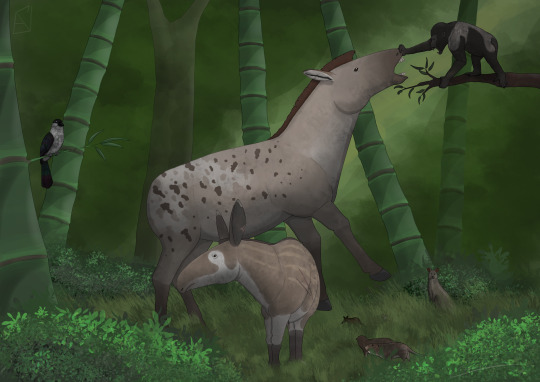
The largest and most noticeable across the forests are the donkeys, now diverse enough to be classified as a subfamily (Asininae), which have managed to colonise these environments on two different occasions:
The first ones were a lineage (tribe Macrocephalippini) that became incresingly more specialised in browsing the lower leaves of trees, growing to larger and larger sizes in order to digest more vegetation more efficiently. The group is not too diverse, with only a couple giants in a single genus (Macrocephalippus), while most of the taxa are pretty basal forest donkeys distributed among two other genera. The larger ones are quite similar behaviourally to Grévy’s zebras, with males establishing territories where females and their foals forage, although it’s not rare for foals of other stallions to disappear. The smaller species are generally solitary or form small herds with only a handful of members.
The second group were a lineage (tribe Tapironini) of grazers that developed shorter legs and a more flexible snouts (like pigs and tapirs) in order to better look through the leaf litter for good forage or to select the right plants in the rare and small grazing grounds in the forest. They are more diverse than the previous group, with almost ten species in it. They’re solitary and tend to avoid each other, as they’re quite nomadic too.
Another quite common group are a lineage of the old endemic rodents that developed an increasingly herbivorous diet, converging with voles and cavies in build and head musculature. They’re quite common on the forest ground, as much as bandicoots, with whom they avoid competition thanks to their more specialised diet. They’re quite skittish animals that forms small “herds” with only a handful of individuals, sometimes as small as two members. They breed year round and sows can give birth to up to six pups, although this many are rare as they’re much more K-selected than other rodents.
The latest arrival to the Australian continent are the two primate lineage that rafted there in the late Catiocene, as Australia gets closer and closer to Asia, impacting as it goes more and more Australasian islands. It is now closest to Wallacea where these two groups come from.

The earliest to arrive were tarsiers. Not too different from their Asian relatives they still hunt insects and other invertebrates in the canopy, with the only difference being a wider variety of colourations.
The latest were macaques, but even though they’ve reached the continent extremely recently they’ve managed to establish a foothold, with ape-like forms being visible all across the Northern Territory and Queensland’s canopies. They’re quite aggressive animals, employing a strategy similar to honey badgers by picking fights with animals clearly out of their weight category and not letting attackers escape unscathed, in order to discourage predation. They live in large mixed sex troops with clear and complex hierarchies, with makes and females in two different ones. Individuals higher on the social scale are the first to have access to resources and mates, and in order to stay at the top of the hierarchy they frequently bully less dominant individuals (tipically of the same gender). Infants inherit their mother’s social status but can climb the social ladder by challenging more dominant individuals, although males tend to do so more often as even the least dominant females still get “courted” when ovulating and and are able to forage thanks to their sisters’ help, something males don’t usually don’t rely on.
#spec bio#spec evo#speculative biology#speculative evolution#artwork#digital art#future earth#future evolution#worldbuilding#epigene period
30 notes
·
View notes
Text
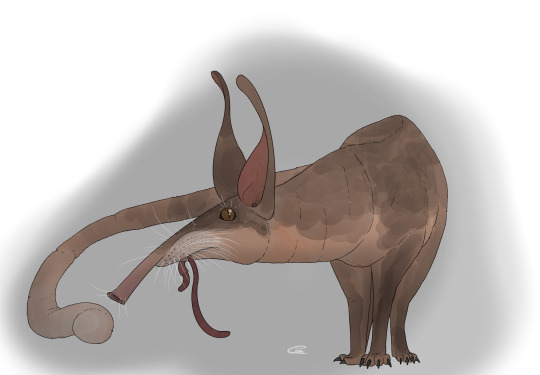
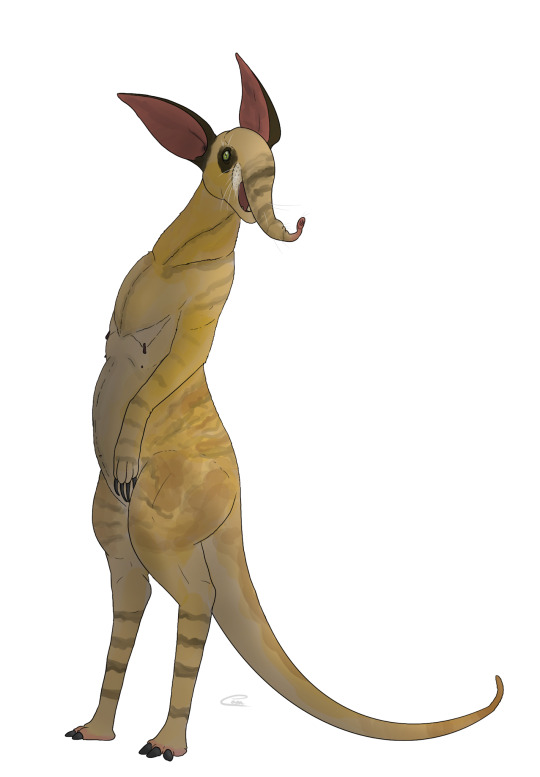


Six afrotherians related to sengis that I made for the late Eocene of After Impact, an alternative cenozoic community project. The latter three will end up in the Oligocene submissions tho.
35 notes
·
View notes
Text
Some critters I’ve done for the Phase I of 22 million years ahead, a future evo community project by Jackosaur (idk if he’s here but he’s definitely on twitter so check his stuff out) about the future of North America








#spec bio#spec evo#speculative biology#speculative evolution#artwork#digital art#future earth#future evolution#22millionyearsahead
44 notes
·
View notes
Text
As the Beringia landbridge united North America and Asia and the biotic interchange between the two continents took place much of the fauna from the former got replaced by that from the latter, forcing many endemic clades to move away in order to survive. Some moved East, while other moved South, into Central America, but as the Eurasian migrants continued their descent they were pushed South, and by the late Catiocene both former North American endemics and the fauna that crossed from Beringia found themselves in a new continent, South America.

A young León platinino (Pampapardus maximianus), a relatively unchanged descendant of the León de las Pampas (Notopardus tiberius), is prowling his territory in what's modern day northern Argentina, looking for prey, rivals or cubs from other litters. At one point he spots a large carnivore, a giant Pampas trash bear (Isarctodactylus ornatus), one of the "invaders" from North America, whose lineage was pushed to the refugia of the East Coast and Southern Mexico, managing to make a last spurt of diversification in a continent devoid of similar fauna. It doesn't need to hide from it, as its main purpose is to scare him away from its territory, and so he goes to intimidate the intruder, who, almost confused rears up to better examine the possible threat.
This species trash bear is definitely the largest carnivoran on the continent, growing to 1 ton in weight, and using its size to overpower slow moving large herbivores, but mostly to intimidate other carnivores away from their kills, as it's not as agile as other predators and can always rely on fruit and grass, unlike the former. This scene would've been a common sight in the late Catiocene, but as time goes on the two species will learn to get used to each other and to coexist.

Another common sight in this time would've been the cetorcs (subfamily Brachypodinae) of the Amazon, that, passing through the seasonal forests on the coast of Mexico were able to reach the Central American rainforests and later South America. Larger and more aggressive than their Asian relatives they quickly became the lords of the forest, "overthrowing" the ground porcupines, while the opposite happened in the Old World.
#spec bio#spec evo#speculative biology#speculative evolution#worldbuilding#artwork#digital art#epigene period#future earth#future evolution
24 notes
·
View notes
Text

Although forests and grasslands have both become quite different from their modern day counterparts, another biome has managed to regain much of its former diversity, and in some cases even managing to increase it, the mountains.
Here specifically we’re going to talk about the mountains of Eurasia, taking the Caucasus as an example, since it has many species in common with the rest of the area’s mountains, up to the Himalayas and in some cases even to the Urals.
The largest predators of these peaks, like almost everywhere in the continent, are cats, here specifically there are three main lineages, along with many smaller ones. The smallest of these are the Pernicofelines, or false lynxes, spread across Afrolaurasia, from the Atlantic coast of Africa up to Yucatan, whose local representative is the ten horned false lynx (Pseudolynx decaceras), that lives off birds, rodents, rabbits and calves of heers, antelopes and goats. Larger is the caucasian Fellimine, the mountain aupard (Aupardus oreophilus), whose preferred prey are the large caballine goats, antelopes and calves of hyraxes. The largest lineage is the Arctofeline lineage, whose main representative here is the bull ounce (Rostrailurops montanus) whose specialisations in hunting megafauna, such as strong forepaws and long canines, convergent with machairodontines, made it the apex predator of these mountains.
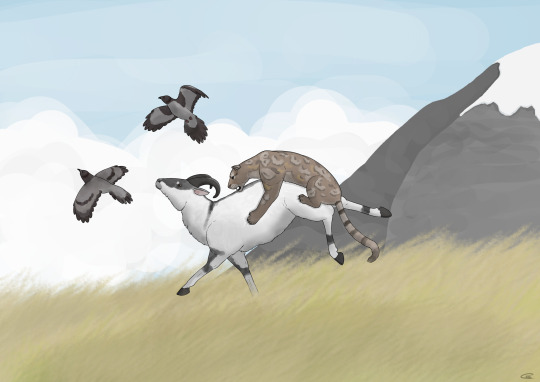
Another important predator of these regions is the Asiatic condor-owl (Strygonyx himalayanus), a larger owl, now capable of soaring between hunting grounds that stalks its prey on foot and swallows it whole.
Here the largest herbivores are borroths (Borrothus sp.), a currently monotypic genus of mountain dwelling holophants with heavy seasonal coats that help them cope with the harsh weather, and the giant cave hyraxes (Protodontarctos ungulatus), with a similarly heavy coat of wool. Other mountain dwellers are antelopes and heers, but the most iconic one are definitely goats, who were able to survive in the peaks of Eurasia and thrive there.
With the Caucasus, Urals, Iranian plateau and Himalayas now being connected it allowed for more specialised mountain dwellers to evolve. One such example are the rat jacks (Rattopus sp.), saltatorial rats with a limb morphology resembling viscachas and other jumping rodents.

#spec bio#spec evo#speculative biology#speculative evolution#worldbuilding#artwork#digital art#epigene period#future earth#future evolution
12 notes
·
View notes
Text
In a forest in what was once the US state of Connecticut a large animal is sleeping. With digestive system not fully capable of digesting its food of choice, it has to sleep somberly for most of the day, and spends the rest of it eating, in order to get the most nutrients possible during its wake hours. This black and white giant, the giant trash panda (Aupanda novoanglicum), is one of the last Diacyonines, bear like raccoons that inhabited the continent for the last twenty million years and lost much of their diversity over the course of this epoch. Now the last ones inhabit only the forests of the northeast and Mexico.

The forests Northeast of the Appalachians thus serve as an important refugium in North America for endemic species that declined over the course of the Catiocene, or fully disappeared in the rest of the continent following the GALBI. There’s plenty of environments here, with really varied forests that trap different amounts of humidity, depending on the kinds of trees, and let different habitats coexist.
One such example are the bamboo forests of New England, mainly found on the coast, that are on average moistier than nearby areas, and other than trash pandas allow for monkeys and even lemurs, introduced to Florida in the Holocene, that later spread to the rest of the East Coast, to thrive.
This varied forested environment also allowed for another raccoon to specialise itself, taking to the trees and developing an almost primate like bodyplan, giving rise to the third procyonid lineage, after olingos and kinkajous, to do so, the misheems (Betulocyon arboreus).

#spec bio#spec evo#speculative biology#speculative evolution#worldbuilding#artwork#digital art#epigene period#future earth#future evolution
27 notes
·
View notes
Text
On the border between Sunda and Australasia there’s an archipelago formed from what once were the islands of Sulawesi, Bali, Timor, Flores and Sumba. Although really close to both Australia, Borneo and Java, there hasn’t yet been any major influx of foreign fauna from either landmass towards the archipelago, thus letting the ecosystems on Wallacea become fairly unique.
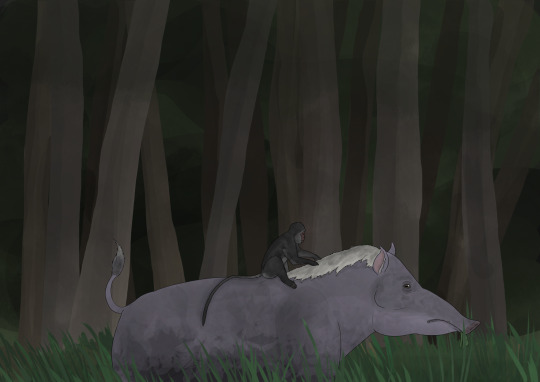
Some of the most abundant inhabitants of the islands are monkeys, particularly macaques, that have evolved a much higher diversity than their Holocene counterparts, with some smaller species even evolving an interesting symbiosis with other, usually large and herbivorous, animals, grooming and ridding them of parasites in exchange for protection.
The most common symbionts of these macaques, and also the most common and widespread herbivores on Wallacea, are pigs, that evolved from two main lineages: the Vittatus lineage, which gave rise to a clade of large bodied fully herbivorous pigs, the giant hogs, that currently only has a handful of species on the different islands of the archipelago, and the Celebensis lineage, from which small peccary like forms, that retained a more omnivorous diet, evolved, the lesser swines, with a much higher diversity across the isles.

What really sets these islands apart, tho, are the predators, that evolved from the only native carnivoran of Sulawesi, the Sulawesi palm civet. They’ve evolved into many forms, with the most derived being weirdly convergent with fossas and big cats, evolving a deeper and shorter skull, and even the ability to grapple prey with their forelimbs.
#spec evo#spec bio#speculative evolution#speculative biology#worldbuilding#artwork#digital art#epigene period#future earth#future evolution
21 notes
·
View notes
Text
On the rocks of the East China Sea’s shores one of the largest reptiles of its epoch is sleeping, basking in the warmth of the midday sun. This species mostly feeds on fish, but they don’t dislike other aquatic prey items such as small dolphins, lutters or seabirds. Nonetheless this couple of murrelons (Xenygropteryx nippon) aren’t particularly scared and will rest on its back.

Although sea going reptiles this large are mostly associated with the Mesozoic another lineage has evolved from the australasian false gharial, spreading into most of the Indian Ocean, even reaching the Aethiopian coasts.
Until the Anectyocene-Catiocene boundary they were relegated to the coasts of Indonesia, but they later spread westwards and northwards, even reaching the Sea of Japan. There the largest member of this lineage, and also the current largest crocodilian has evolved, the Ishihebi gharial (Toyotamasuchus kamikaze).

The buaya gharial (Toyotamasuchus sundaenis), the other Toyotamasuchus species inhabiting warmer and more southern waters
It inhabits different habitats during its lifetime, hatching upstream in rivers and slowly descending towards the sea during their life. The largest portion of their immature life is spent in estuaries where they form coalitions to fend off predators, such as the Yangtze imperial crocodile (Anaxosuchus imperialis) or the many cats that inhabit the area. After reaching adulthood they spend most of their life at sea, only coming to the beach to rest or mate, often forming temporary harems on the shores, as males tend to be less in number due to the relatively colder environment where they live.
#spec evo#spec bio#speculative evolution#speculative biology#worldbuilding#artwork#digital art#epigene period#future earth#future evolution
12 notes
·
View notes
Text
The reduction of savannah ecosystems across northern and central Florida over the last few million years allowed for a corridor of more forested areas to be created. This would help the formerly introduced New world monkeys of Florida, mostly cebids in origins, to migrate northwards into much of the South-East of the continent.
Here we’ll take a look at two forms that made it past the Everglades:

A male and a female hazzardin with an infant on a tree branch
The hazzardins or hazzartz monkeys (Irideocebus dixiensis) are a species of extremely sexually dimorphic monkeys. The males have bright blond and blue fur, with a more ginger hue during their earlier stages of maturity. They’re relatively large for a New world monkey and live in harems. Weirdly enough for a haremic animal the father actively takes part in the care of his offspring, with their well-being acting as an important part of its display towards potential mates.
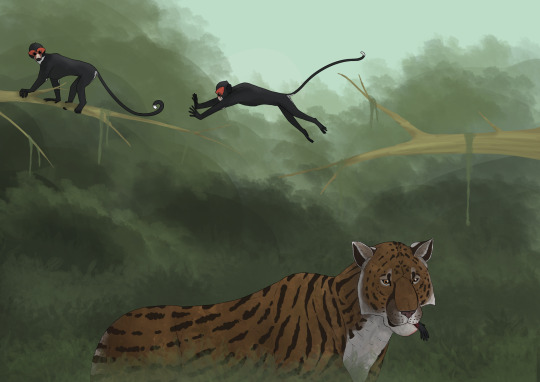
A coalition of female chipihs observing the swamp elkat (Amphiailurus americanus floridanus) that caught their sister
The red faced chipihs (Umbrops niger) have adopted a lankier more elongated bodyplan, better adapted for their life in the canopy. Males and females don’t differ much, and both have complex facial markings and bright red eyebrow fur used for display. The only differ between the sexes are the white markings around the anal and perineal regions of females that they show to males to initiate mating practices. They live in coalitions of brothers or sisters that often engage temporarily with other groups for grooming, breeding or mobbing predators.
#spec evo#spec bio#speculative evolution#speculative biology#worldbuilding#artwork#digital art#epigene period#future earth#future evolution
16 notes
·
View notes
Text

Not far from the coast of what once was the country of Lebanon two giants of the marsh encounter each other. These two behemoths are part of two different lineages that wouldn’t usually meet. The first one is a ratalac (Myochoerus caviomimus), part of a line of nutria descendants that evolved in Europe around the Mediterranean basin, and they can get to around 1,5 tonnes. The second one’s the dembouc (Tragodus augenos), it’s not much smaller and it evolved from indochinese hippo-like chevrotains that moved into India, since it was without large semi-aquatic herbivores, and later reached West Asia in the early Catiocene through wetter corridors on the coasts and south of the Himalayas and Kashmir.
This area, along with the Black sea’s coast is one of the only places where these two hippo mimics meet. They’re both as aggressive and territorial as their Holocene analogues, rarely allowing animals that could pose a threat to them or their offspring, and actively targeting (especially in the case of ratalacs) the few predators that dare to venture in their territory, mobbing and outright trying to kill them.
These two individuals are both aware of their opponent’s strength and will most likely try to intimidate the other or choose to back away, with neither status, offspring nor food being at stake. They often just tolerate each other’s presence, although still at a safe distance.
In the few areas where they coexist they partition by feeding on different types of vegetation, with ratalacs mostly feeding on plants growing under the water line, and demboucs preferring those above it, sometimes even browsing on reeds
#spec evo#spec bio#speculative evolution#speculative biology#worldbuilding#artwork#digital art#epigene period#future earth#future evolution
25 notes
·
View notes
Text
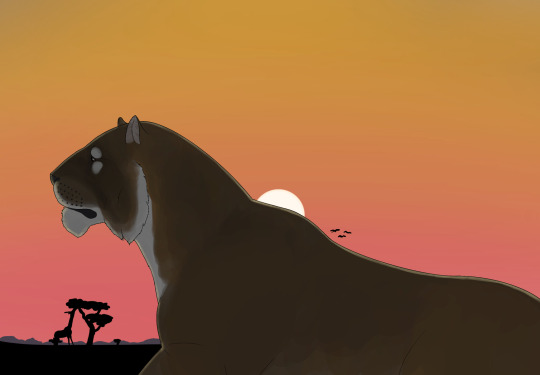
The sun is rising on the savannah. An old cat is resting amidst the grassland. He looks at the territory he held for almost six years at this point, much longer than almost any other male of his species. He’s a Machel’s lion (Leorex macheli), the apex predator of Aethiopia.
This new continent split from mainland Africa just before the interchange and was thus unaffected by it, with many lineages declining or extinct in Afrolaurasia still thriving here, east of the Great Rift Valley and the African Great Lakes.
Moving eastwards and exposed to the currents of the newly formed sea this continent’s climate is slowly but steadily changing. With the Asian monsoons now finally reaching the Eastern coast the first coastal forests are popping up on the edges of the Horn of Africa’s desert, and thanks to the rains brought from the West and strengthened by the equatorial currents the Lake Victoria rainforest was able to expand.

This rainforest is one of the most biodiverse areas of Earth, being so small in size but still hosting so many species. It’s inhabited by a wide array of wildlife. The largest are the ground dwelling primates, the pomorangs (Kampalapithecus chimpiskii), and the many forests antelopes of the genus Relictotragus, or kasolyas.; reptiles and birds alike inhabit the forest, with the most notable ones being pythons, water monitors, parrots and the junglefowl introduced in the Holocene; and a lineage extinct in the rest of the world is still found here, the Smutsiinae, with the still thriving East African giant pangolin (Catiosmutsia aethiopica).
The savannah doesn’t differ much from that of the Anectyocene, with cats, antelopes, dogs, perdvarks and gouebeervarks still being the most common sight there. The main difference here is the evolution of the tomeutheriid, and thus hyracoid, Zoshkoko (Tomeutherium ingens), the largest land animal of the continent, reaching 4 metres in height and rivaling the Pleistocene straight tusked elephant at around 14 tons in weight.
In the last million years there has also been a remarkable case of convergent evolution, with a population of laangvos adapting to a more frugivorous diet and establishing a symbiotic relationship with the Kei apple, eventually evolving into the shaggy wolf (Phytocyon keiophilus), uncannily similar to the maned wolves of South America.

#spec evo#spec bio#speculative evolution#speculative biology#worldbuilding#artwork#digital art#epigene period#future earth#future evolution
10 notes
·
View notes
Text
Despite the general cooling of the planet one particular continent is starting to warm up, allowing a more varied climate better suited for both plant and animal life.
Antarctica has been fully covered in ice for the last 30 million years, but now thanks to its movement northwards and the formation of the Magellan islands between the Antarctic Peninsula and Tierra del Fuego the flow of the Antarctic Circumpolar Current has been broken, allowing warm currents to go along the Pacific coast.
The dominant biome here is tundra and cold prairies, broken by rivers and wetlands.

The largest animals here are all birds. The most common herbivores are flightless ducks and other anseriforms, that get preyed upon by large, but still well adapted for flight, terrestrial birds. These peregrine falcon descendants (Gyrornis ambulans) have developed a hunting strategy much different from that of its ancestor, now basically pouncing on their prey, aided by their wings, and crushing their windpipes with a bite to the neck, in a similar fashion to cats. Although specialised for larger prey they’re also able to take smaller game, allowing it to spread into South America where it feeds on small rodents, youngs of bigger animals and birds.

An unlikely inhabitant of these grasslands is a flightless bird, similar to an upright kiwi that feeds on insects and eggs. Unlike any other bird in the area, its posture, almost plantigrade feet and flattened wings show his ancestry. It’s a penguit (Erectopteryx palmeri), a descendant of small penguins that exploited the new Antarctic environments early on, becoming a quite successful generalist.

The richest ecosystem on the continent are the cold wetlands brought forth by the melting glaciers. These immense areas are a biodiversity hotspot where a myriad of aquatic and semiaquatic species live. At the base of the food chain there’s many freshwater fish lineages, in this case cichlids, trouts and salmons, and semiaquatic insects, like dragonflies and mayflies, that got here from South America. The biggest river predator is the garlachea (Garlachea antarctica), a large salmonid similar to the Amazonian arapaima or to sturgeons. It shares the environment with many semiaquatic mammals, like the English otter (Pyrolutra anglolittoralis), many aquatic rodents, and one of the biggest monotremes yet, the giant polar platypus (Neopilopus fluvialis) that bottom feeds and occasionally catches small fish and other vertebrates.
The swarms of insects feed many more animals, attracting flocks of bats and birds, and feeding the ground dwelling flightless bats and semi-terrestrial salmonids.
#spec evo#spec bio#speculative evolution#speculative biology#worldbuilding#artwork#digital art#epigene period#future earth#future evolution
19 notes
·
View notes
Text
On the coast of the Bay of Bengal a pair of relatively large corvids is walking by looking for food. It’s their first year together and she hasn’t yet laid any eggs, so they can still forage together without worrying about their chicks.
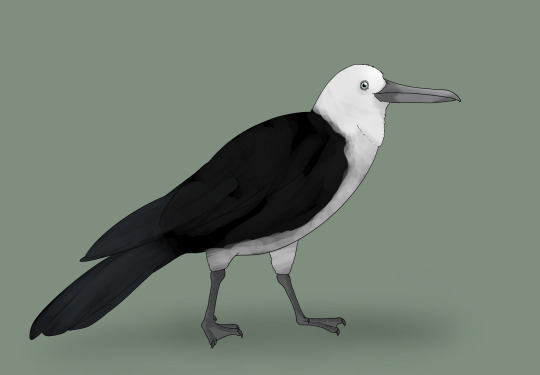
These two birds are sea crows (Thalattocorvus albocephalus), opportunistic omnivores like their ancestors, although showing traits for a seagoing lifestyle: webbed feet, a long and slender bill, hydrophobic feathers and salt glands. They evolved over the course of the last ten million years in response to the shrinking jungle and retreating coastline, caused by the northward movement of the Indian plate. They now thrive in this newly formed shallow sea, scavenging on the coast, diving for fish and occasionally foraging in the forests. Some populations were even able to establish themselves outside of the Sea of Bengal, reaching as far West as Arabia and the Horn of Africa, and as far South as Sumatra.

Going back to our protagonists, the couple has just spotted some nesting lutters, earless phutrids, coming back from their hunt with small fish for their pups. Although usually wary of animals this big, the food brought by these mothers presents a great opportunity for the two. After choosing their targets they set their simple but clever plan in motion. While one of them distracts her the other catches an anchovy and both fly away.
Showing a great degree of adaptability, intelligence and ability to strategise these corvids will be able to establish themselves as some of the most successful birds in the seas of the Epigene and eventually some of the most common.
#spec evo#spec bio#speculative evolution#speculative biology#worldbuilding#artwork#digital art#epigene period#future earth#future evolution
26 notes
·
View notes